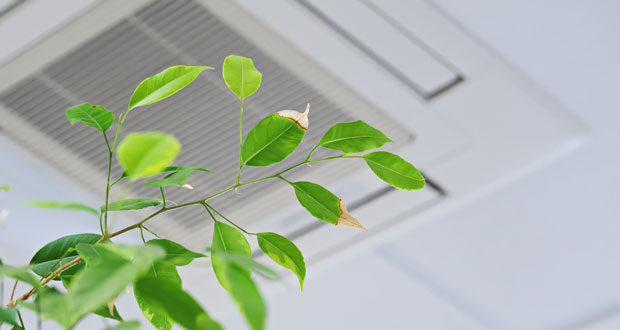 Leveraging the right technologies to manage Indoor Air Quality (IAQ) can mean better occupant wellbeing, energy savings, and increased ROI says Tyler A. Smith, Vice President, Healthy Buildings, Johnson Controls
Leveraging the right technologies to manage Indoor Air Quality (IAQ) can mean better occupant wellbeing, energy savings, and increased ROI says Tyler A. Smith, Vice President, Healthy Buildings, Johnson Controls
Temperature has often been the first thing people think about when considering the air inside a building, but that’s changing as there is a greater understanding of the impact air quality has on occupant health and performance.
From pollen to pollution, indoor air contaminants can impact anyone, with detrimental effects including seasonal flu, allergies or asthma. Symptoms like cough, headache and poor concentration can be disruptive and, in the case of a virus, easily spread to other workers.
As a result, poor IAQ can affect employees’ attendance as well as their safety. Indoor air contaminants can also decrease employee comfort and make it harder for them to focus and collaborate on complex tasks. For employers, problems with IAQ can lead to absenteeism, presenteeism (working while sick), reduced employee retention and lower productivity.
Workers who feel healthy and comfortable may be more likely to want to return to a space every day. And, when people feel better, they often perform better.
IAQ CONSIDERATIONS
Today’s buildings are often constructed in an airtight way to save energy on heating and cooling. The consequence of this design is a lack of fresh outdoor air supply. That lack of fresh air brings the need to find new ways to combat indoor contaminants.
For example, volatile organic compounds can be given off by carpets, furniture, paint and cleaning products. Carbon monoxide can be emitted from fuel-burning furnaces, water heaters and lab equipment. Contaminants also come from our bodies in the form of exhaled carbon dioxide and viruses like COVID-19, measles and the seasonal flu.
The humidity of a space is also a key component of healthy IAQ. When the humidity is too low, it can cause itchy skin and eyes as well as rashes, and it can dry out sinus membranes. When humidity is too high, it can worsen asthma and allergy symptoms and make it easier for dangerous bacteria and mould to grow. Areas like restrooms, kitchens and showers can generate significant moisture and are likely spots for risk factors related to high humidity.
With the ebb and flow of people and seasons, buildings are dynamic systems that change based on their occupancy and usage. That means IAQ is continuously shifting along with the weather, outdoor air quality, number of occupants, time of day and how building systems are performing.
HOW SMART BUILDING SOLUTIONS IMPROVE IAQ
Improving IAQ should be part of risk reduction in any environmental, health and safety (EHS) plan. However, it’s not enough to purchase new equipment for buildings and trust that air quality will improve. To truly be successful, a building’s air quality must be thoroughly assessed to determine where problems may lie.
Smart solutions can help to reliably track and continuously optimise building air quality, and include systems that allows IAQ experts to review data and provide insights and recommendations on how to improve performance.
Even well-managed buildings can experience periods of poor indoor air quality, and a smart system dynamically adapts to changing conditions in buildings to maintain healthy IAQ. This capability is especially important during time periods when allergy and asthma symptoms are more difficult to manage.
Then there are solutions that go even farther. IAQ subscription services combine technology and science-backed expertise to provide building owners with a long-term, proactive approach to indoor air quality that can address emerging and existing challenges. By using a subscription service, buildings receive a tailored approach to clean air that can also maximise efficiency, energy and cost savings. Some subscriptions can even be bundled with sustainability and building management subscriptions for total building optimisation.
By optimising on indoor air quality using these smart solutions, building owners can uncover other issues and improve building aspects from all angles. Optimised humidity levels, for instance, can reduce or prevent mould growth. Some buildings are under or over ventilated related to their occupancy. Using an IAQ and building management service in tandem, building ventilation can accurately match occupancy.
IAQ CAN DRIVE ENERGY SAVINGS
Part of an IAQ plan should include considerations around energy usage and ventilation levels. With a measurable and adaptable HVAC strategy that controls ventilation based on carbon dioxide (CO2) levels, ventilation rates can be adjusted as CO2 rises or falls in line with occupancy, saving energy and improving IAQ.
Consider an office that is over-ventilated, or one that is heavily occupied with poor ventilation. The former is wasting energy, while the latter is contributing to health risks and impacting productivity. Packaging an adaptable ventilation strategy with an IAQ assessment delivers a detailed roadmap for IAQ and sustainability, enabling facility owners and managers to maximise their investment in IAQ – and some data suggests employing these smart strategies may also lead to significant energy usage savings.
IAQ improvements cultivate a healthy environment for all occupants, which is why cooperation between building management and occupants is essential for success. When the quality of the air everyone breathes is prioritised, everyone benefits.





